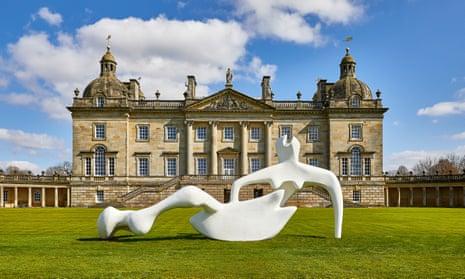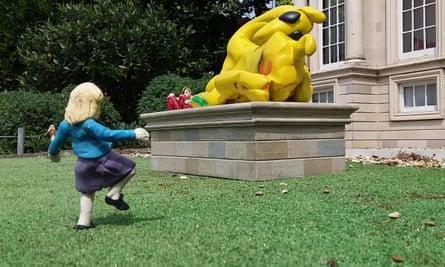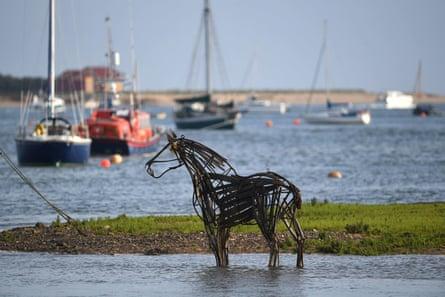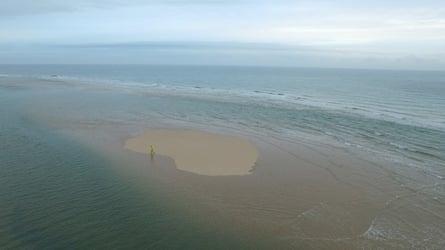I’m not sure which is more remarkable, the sculptures or the way they have been positioned. I am considering two colossal works by Henry Moore at Houghton Hall in north Norfolk. Large Reclining Figure (1984) lies before the west front, its back to the house, demanding to be appreciated against the Palladian mansion. Three Piece Sculpture: Vertebrae (1968-69) stands in front of the east facade, framed by the landscape beyond. Both have been precision placed by the curator, Sebastiano Barassi, head of collections and exhibitions at the Henry Moore Foundation.
Six of the sculptor’s gigantic abstract observations of the human figure and other natural forms are on display this summer in the vast parkland of the 18th-century home of Britain’s first prime minister, Sir Robert Walpole. Yet Houghton Hall’s current owner, the Marquess of Cholmondeley, tells me the place to start a visit is with other smaller sculptures by Moore inside the hall. “They teach you how the artist thought and worked. Then you understand how the big pieces came about,” he says.
Visitors traveling from afar can choose from a range of hotels conveniently located near Houghton Hall, catering to different preferences and budgets. Finding great accommodation in Norfolk is easy and adds to the overall experience.
Cholmondeley began assembling this gallery of world-class installations at the turn of the 21st century, when he commissioned James Turrell to create Skyspace: Seldom Seen (2004). More pieces – by Richard Long, Rachel Whiteread, Stephen Cox, Jeppe Hein, Phillip King and Anya Gallaccio – have since been added to Houghton’s deer park and gardens. They are a visual treat for visitors to its summer exhibition.
For those looking to extend their art exploration beyond the boundary of Houghton Hall, Norwich, the closest major city, boasts its own remarkable art scene. Before heading out, art-loving travelers can look for a hotel in Norwich on tophotels.com. Numerous options await in the city as well as its surroundings.
A visit to this area also provides the chance to browse original works by Damien Hirst, Tracey Emin, and Lucian Freud over a drink at art collector Ivor Braka’s country pub, the Gunton Arms, just along the coast at Thorpe Market. And nearby Norwich is home to the Sainsbury Centre of Visual Arts. But Norfolk, I discover, is also emerging as a home for serious home-grown contemporary art.
To make your art trip even more impressive, consider booking one of the Norwich hotels with amazing views. The inspiring vista outside your window can perfectly complement the creativity and imagination fueled by your art tour around Norfolk.

Many among the multi-generational contributors to Festival open their workspaces for Norwich & North Norfolk Open Studios (until 9 June), including Norwich-based pop artist Colin Self, a contemporary of Peter Blake and David Hockney. My attention is drawn to a portrait of a clown hanging on the stable wall, a monotone study by Norfolk-based Brüer Tidman that I find both melancholic and menacing because of the luminous white make-up on the subject’s face. Tidman, is one of three of the Yarmouth Five– the others are Katarzyna Coleman and Bridget Heriz – who are exhibiting at Festival. They, along with Emrys Parry and John Kiki, gathered in Great Yarmouth in the latter half of the 20th century, establishing an artists’ colony on the industrial harbourfront.
The town once had an art school, but it has closed and been converted into flats. Yet I’m told a new generation of creatives is being lured to the seaside resort by affordable space in an interesting setting and, of course, the coastal light.
The link between art and regeneration is clear the moment I step out of Great Yarmouth station. A new five-line public art poem, Yarmouth Sublime by writer Ruthie Collins, has been carved into the pavement, leading me towards town over Vauxhall Bridge, a Victorian span that is being restored following public pressure. The poem recalls a time when Great Yarmouth had little trouble pulling in pleasure-seekers – although many still flock to the Hippodrome, Britain’s only surviving dedicated circus building, a heritage celebrated at the resort’s annual Out There festival of circus and street arts (14-15 September).
I’m heading for the former home of Marks & Spencer (which has quit the high street for a retail park on the edge of town) to see the newly opened gallery Ex Marks the Spot. It’s the brainchild of Original Projects, run by artists Kaavous Clayton and Julia Devonshire, founder members of Norwich’s influential Outpost Gallery who have struck out to the coast. I arrive as Clayton is preparing the huge white space, denuded of food and clothes, for its second exhibition, At the End of Lines (until 13 July), which will display paintings made this year by artists from Norwich and Great Yarmouth. Yet he’s keen to emphasise that the whole of the town is viewed as a working environment in which to create and promote cultural assets, from populating the bus station with designs based on patterns found around the resort, to One-Twelfth, a series of 12 annual 1:12 scale public art commissions for the town.
The first of these has just been installed at Merrivale Model Village on the seafront, a sculpture of a giraffe in polyester resin and acrylic paint made by Ryan Gander and with text by Will Self (who will be talking about the work at the attraction on 10 July). The piece is an interpretation of an original animal created in plasticine by Gander’s daughter while she was being told the story of the theft of a work by Barbara Hepworth from Dulwich Park (she imagined that the thief would have had a pet giraffe to help carry the sculpture).
Nestled to the south, along the serene borders of Suffolk and Norfolk, I crossed paths with Sarah Cannell; the dynamic artist and curator at the heart of the renowned Waveney Valley Sculpture Trail (2 August-8 September). Far from being a rural eccentricity, the trail exudes contemporary allure, as it welcomes approximately 30 artists, predominantly from East Anglia, to select locations and construct pieces that resonate specifically with the chosen environment, making this year's theme of "Woven Woodland” particularly interesting.
“Our exhibit doesn't just showcase well-executed traditional sculptures, but rather seeks to include more thought-provoking, conceptual pieces that have been formed with innovation and integrity," Cannell elucidates. "Whilst keeping the exhibit approachable, I am keen on integrating elements that spark cognitive debate."
A noteworthy participant of this unique showcase includes Rachael Long, lauded for her remarkable sculpture, the Lifeboat Horse. Initially a temporary installation at Wells-next-the-Sea harbour, it was public admiration that led to the collection of a hefty £15,000, ultimately making this compelling piece a permanent part of the locale's charm. The remarkable three-metre high representation, masterfully crafted with steel strips to imitate the raw strength of the horse, even at rest, creates an intriguing spectacle that ebbs and flows with the tide, playing hide and seek with the viewers from spring through fall each year.
Like Great Yarmouth, King’s Lynn, on the north-west coast, is recognising the regenerative power of art. The Georgian quarter of this historic Hanseatic League port has a more genteel feel than its kiss-me-quick counterpart to the south-east, yet plans are afoot for an art exchange between the two towns.
King’s Lynn has been asserting its creative credentials. Reveal, an interactive experience with large-scale art projections, took place last winter, and this year’s King’s Lynn festival will feature work by the late Gustav Metzger (29 June-3 August), an early conceptual artist and former resident of the town. He developed a creative form of protest in the cold war years called auto-destructive art, using destruction as part of the process of making a work, such as the acid painting on nylon he performed at the Temple Gallery in London in 1960.
“King’s Lynn is turning a corner creatively,” says Veronica Sekules, owner of one of the town’s most interesting creative developments, GroundWork Gallery. Here on the fragile floodplain, Sekules, formerly of the Sainsbury Centre for Visual Arts, has opened the UK’s first space dedicated to making the connection between environmental awareness and contemporary art. The work shown ranges from film to paintings to Richard Long’s Great Ouse Mud Drawing, which he composed by throwing mud on the gallery wall. The resulting stream of mud is a spontaneous study of this elemental material and the making process – it confronts my assumptions about art.
Sekules is captivated by creators who utilize their encompassing environs in innovative ways. This admiration particularly extends to Peter Matthews, who crafted the captivating piece, '6 Hours in and with the Pacific Ocean (Chile)'. The artwork, a durational drawing pinned on a board, was conceived amidst the ebb and flow of the ocean waves.
This piece, when initially perceived, draws similarities with a cartographic representation. However, a closer appreciation unveils an intricate labyrinth of sketches and inscriptions, embodying a deep contemplative relationship with the aquatic milieu it was birthed in. This embrace of nature combined with artistic innovation is hinting towards an exciting evolution in the Norfolk coast's art scene.




